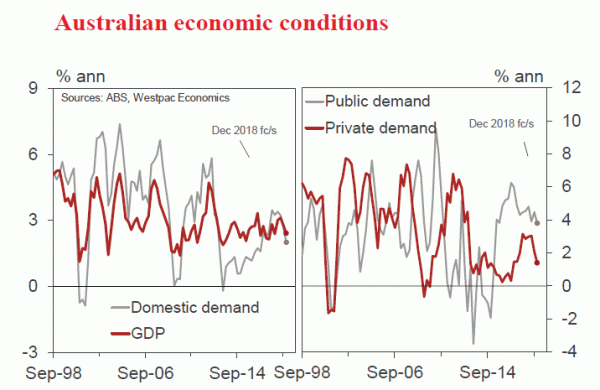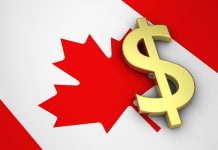Real GDP: f/c 0.2%qtr, 2.4%yr, Domestic demand: f/c 0.2%qtr, 2.0%yr
- The Australian National Accounts, to be released on Wednesday March 6, will provide an estimate of economic activity for the December quarter.
- The economy experienced a considerable loss of momentum from mid-2018. Growth was 4% annualised over the first half of the year, slowing to as little as a 1% pace in the second half. Key to this development is the turning down of the housing sector, as lending conditions were tightened further, and the consumer, constrained by weak wages growth and weighed down by high debt levels and falling house price.
- Recall, in the September quarter, real GDP grew by 0.3%qtr, 2.8%yr. The arithmetic for the quarter was: domestic demand 0.3%; inventories, -0.3ppts; and net exports +0.3ppts.
- For the December quarter, we expect real GDP growth of 0.2%, slowing annual growth to 2.4%.
- The Q4 arithmetic is: domestic demand +0.2%; inventories 0.1ppts; and net exports -0.1ppt.
- There was an absence of strength in the December quarter, in part due to unfavourable weather (Sydney experienced above average rain, delaying construction work, while much of regional NSW remains in drought).
- The partials suggest / reveal that: retail sales stalled (+0.1%, including a -1.1% for NSW); construction activity declined sharply, -3.1% (a sizeable fall in housing, sharp drop in public works and softness in business); and exports likely stalled (dented by rural goods reflecting the ongoing drought).
- Private final demand (the sum of the consumer, housing and business) may have stalled over the second half of 2018, a -0.1% outcome in Q3 and a forecast +0.1% in Q4.
- The labour market was somewhat mixed in the quarter. Employment numbers grew at a reasonable pace, around 0.7%qtr, 2.3%yr. However hours worked rose by a more modest +0.4%qtr, 1.5%yr. As to productivity, this may have declined in Q4 in part due to weather disruptions.
- On the consumer, accounting for 57% of domestic demand, the national accounts provide us with a detailed update on spending, saving and incomes.
- National income is a point of strength and the December quarter was a positive one. Commodity prices moved higher and the terms of trade increased by 2.5%qtr, 5.5%yr we estimate. Nominal GDP growth is a forecast 1.0%qtr, 5.4%yr.
- The Business Indicators survey, on Monday, will provide partial information on incomes for the quarter, including wages and profits, key inputs into our GDP(I) view.
- For 2019, we expect GDP growth to be around 2.2%, with: consumer spending sluggish; home building activity contracting sharply; business equipment spending weak (in part due to uncertainty around the Federal election); but strength in government demand and a positive contribution from net exports, led by LNG (additional capacity) and services (strong demand from the Asian region and supported by the low Australian dollar).
- Against this backdrop and with uncertainty around the election, jobs growth is likely to ease, moderating to a pace below that for working age population (currently around 1.7%), placing upward pressure on the unemployment rate.
Household consumption (0.5%qtr, 1.9%yr): A choppy consumer spending profile (at least in the official estimates) appears to have given way to a period of softness. In mid- 2018, annual consumption growth was 2.9%. But in Q3, spending grew by only 0.3% and we expect a sluggish 0.5% in Q4. Retailing, +2.4% in the year to June, all but stalled over the second half of 2018 (+0.2% in Q3 and a +0.1% in Q4). The housing downturn and drought in NSW, as well as ongoing weak wages growth, are clearly having an impact. Vehicle sales have been declining as lending conditions tighten.
Dwelling investment (-3.0%qtr, +3.6%yr): New home building peaked in mid-2018. Strength over the opening two quarters (+4.3% and +4.0%) was followed by sizeable falls (-2.5% and -3.6%). Further declines are in prospect with approvals almost 30% below levels prevailing over the second half of 2017. Renovations remain choppy, up in Q3 but reversing in Q4.
New business investment (+0.4%qtr, -0.7%yr): A mixed quarter, with gains in equipment, led by the service sectors (0.7% in capex survey) and most likely computer software but with commercial building broadly flat (-0.2%) and infrastructure activity easing (-1.3%) following the recent finalisation of major gas projects.
Public spending (0.4%qtr, 3.8%yr): Public demand has been a key growth driver and we see further upside particularly with tax revenues boosted by higher commodity prices and low government borrowing rates. However, public construction hit a pot hole in Q4, down 6.0% (bottlenecks and weather may have been a factor). Public consumption spending (including health) is a potential upside risk for the quarter.
Net exports (-0.1ppt, +0.9ppts yr): Exports stalled over the second half of 2018 (dented by drought and supply disruptions in the resource sector). Imports rose modestly following a surprise dip in Q3 – a profile which has net exports swing from +0.3ppts in Q3 to -0.1ppt in Q4.
Private non–farm inventories (+0.3%, +0.1ppt contribution): Inventory levels, which typically rise to meet expanding demand, stalled in Q3. We anticipate a modest rise in Q4, which would see them make a small 0.1ppt contribution.














